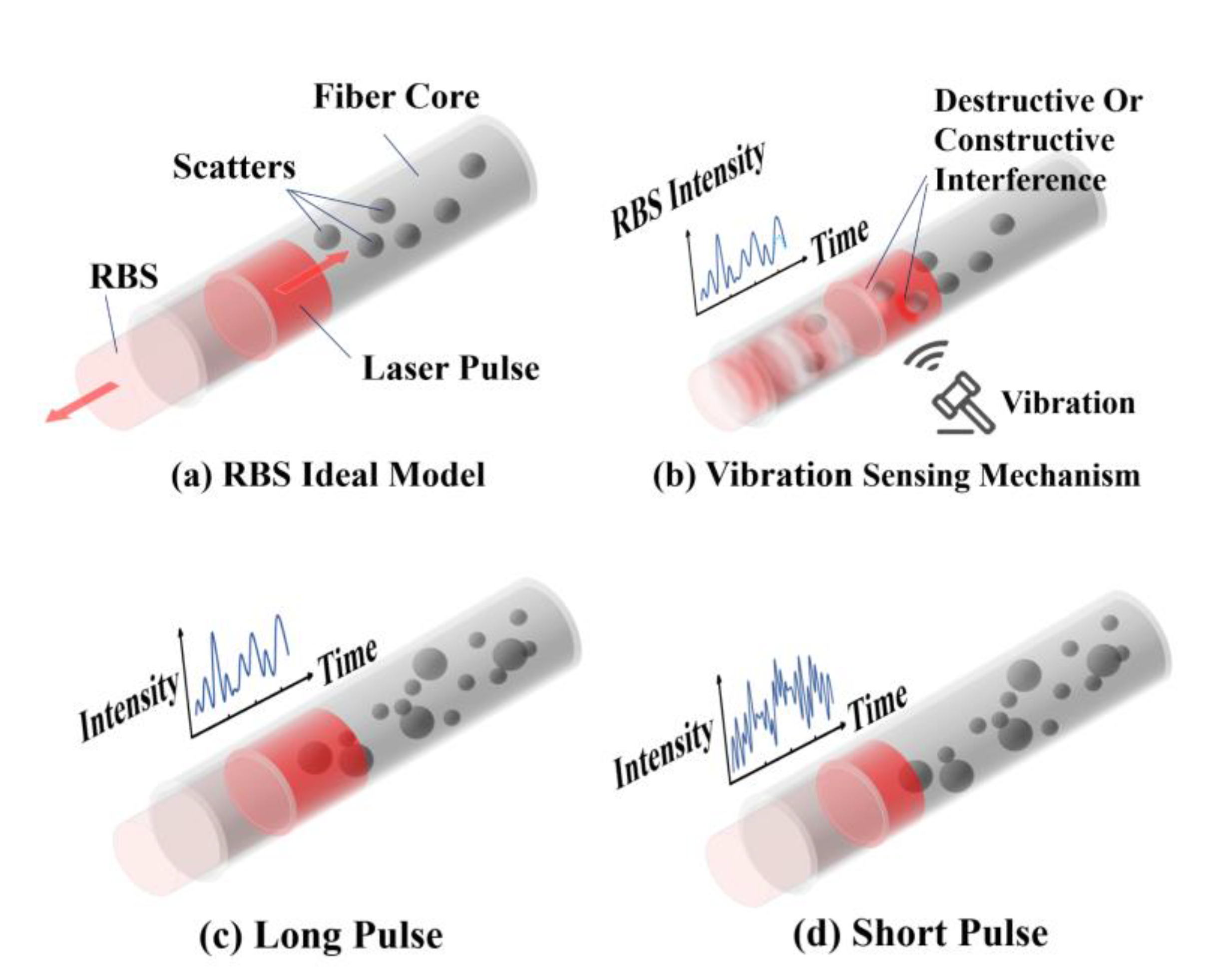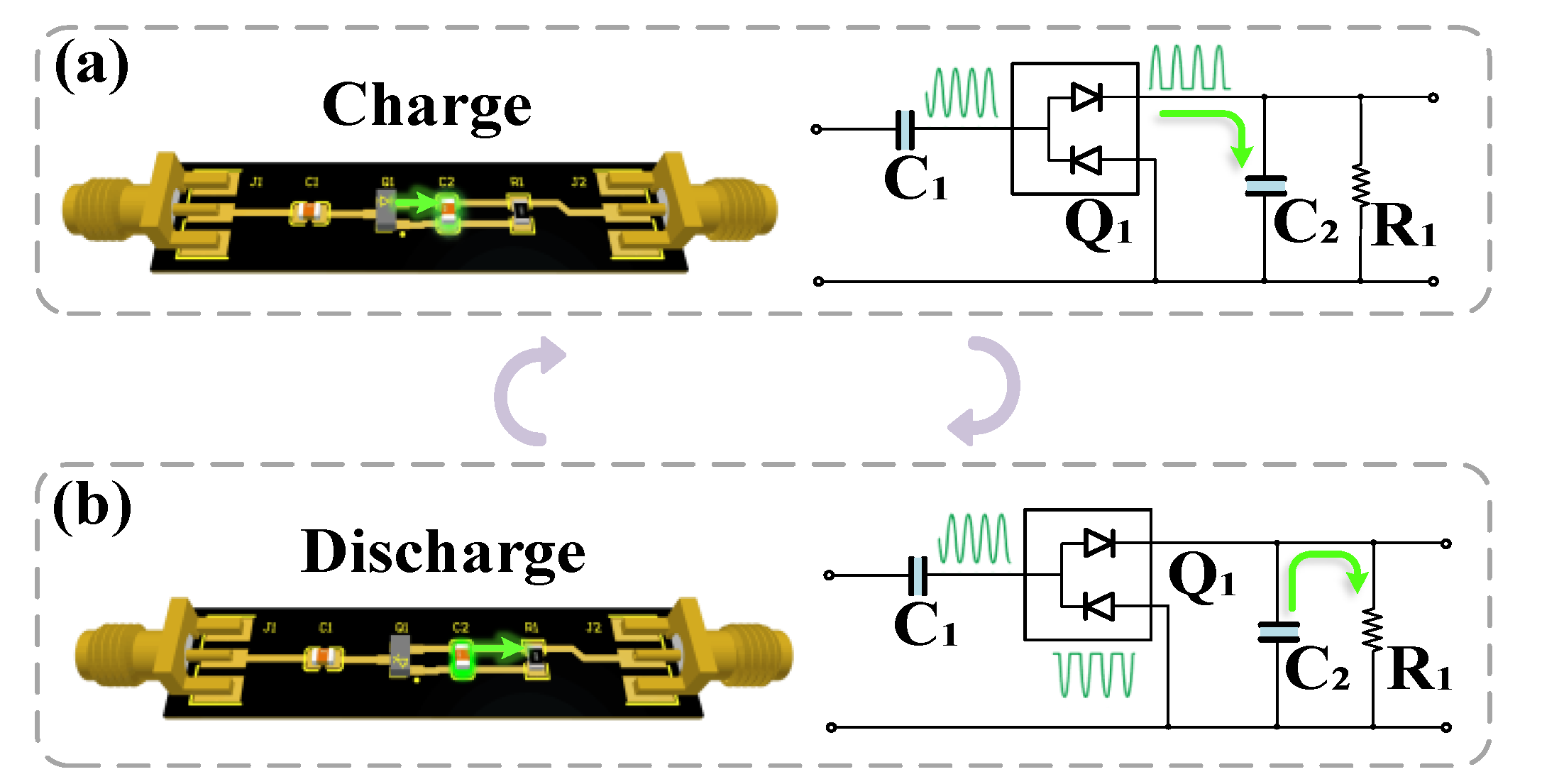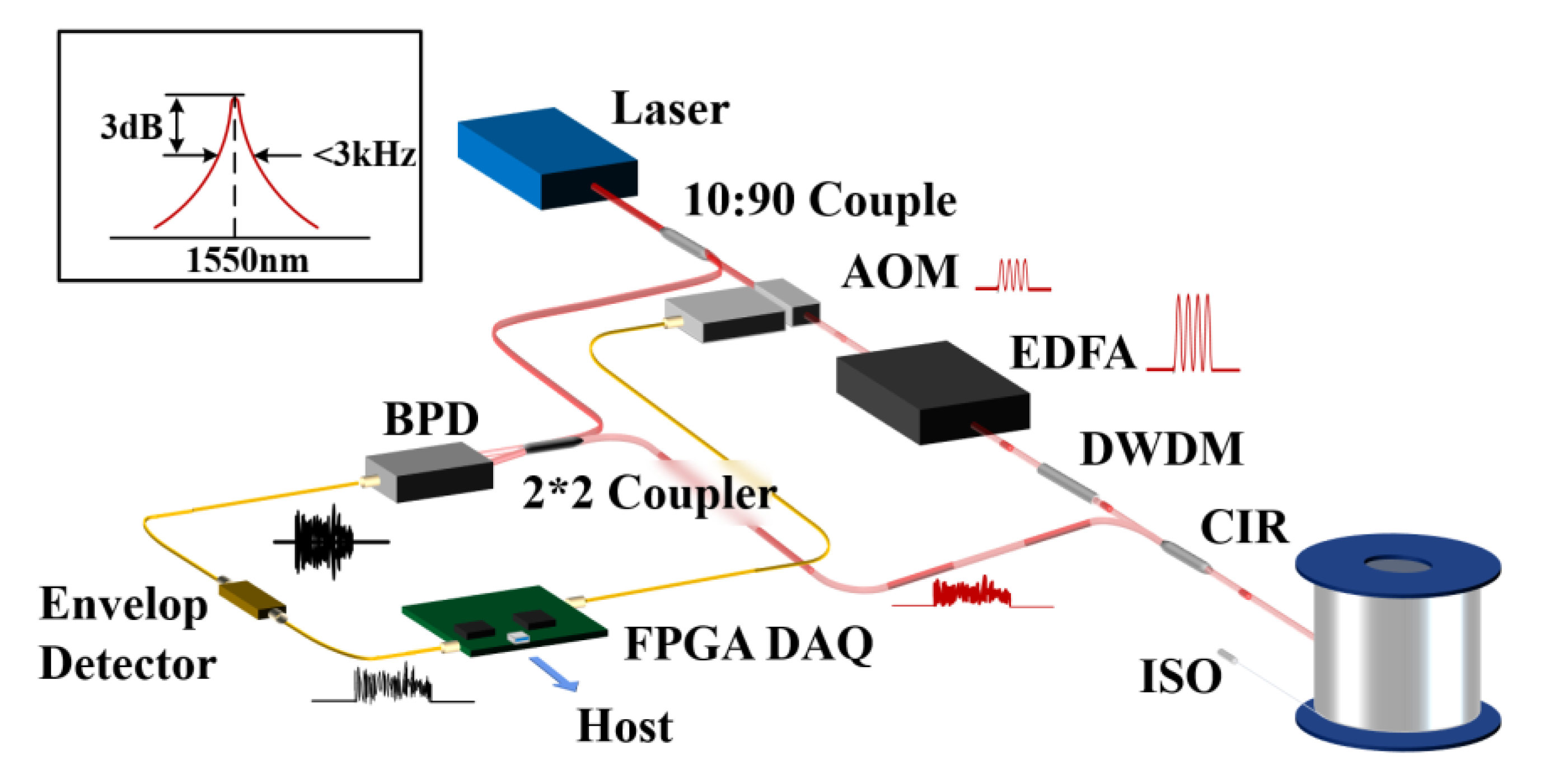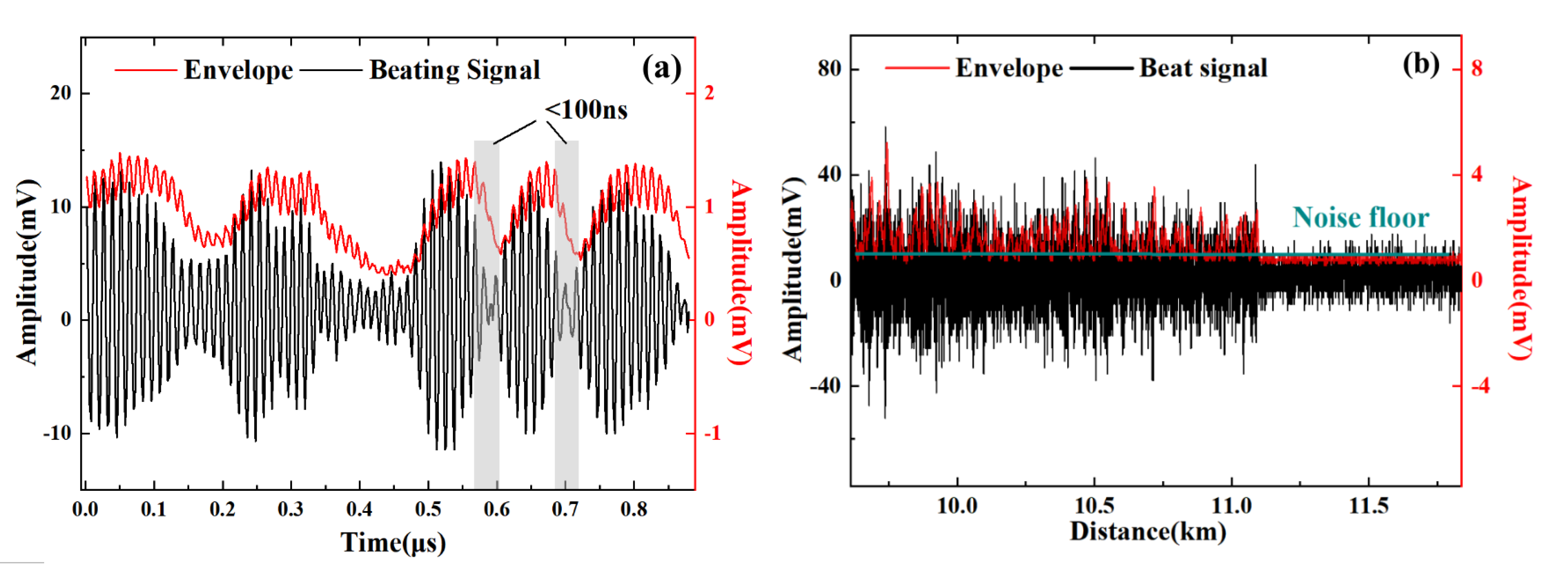Envelope Extraction for Vibration Locating in Coherent Φ-OTDR
Abstract
:1. Introduction
2. Theoretical Analysis and Principles
2.1. Backscattering Model of Coherent Φ-OTDR
2.2. Demodulation Principle of Envelope Extraction
3. System Description and Implementation
3.1. Experimental Setup
3.2. System Testing and Preliminary Analysis of Envelope Signals
3.3. Effect of Different Carrier Frequencies
4. Results and Discussion
4.1. Spatial Resolution Analysis with Different Sampling Rates
4.2. SNR Analysis in Vibration Locating Experiment
5. Conclusions
Author Contributions
Funding
Institutional Review Board Statement
Informed Consent Statement
Data Availability Statement
Acknowledgments
Conflicts of Interest
References
- Zinsou, R.; Liu, X.; Wang, Y.; Zhang, J.; Wang, Y.; Jin, B. Recent Progress in the Performance Enhancement of Phase-Sensitive OTDR Vibration Sensing Systems. Sensors 2019, 19, 1709. [Google Scholar] [CrossRef] [PubMed] [Green Version]
- Wang, Z.; Lu, B.; Ye, Q.; Cai, H. Recent Progress in Distributed Fiber Acoustic Sensing with Φ-OTDR. Sensors 2020, 20, 6594. [Google Scholar] [CrossRef] [PubMed]
- Li, S.; Peng, R.; Liu, Z. A Surveillance System for Urban Buried Pipeline Subject to Third-Party Threats Based on Fiber Optic Sensing and Convolutional Neural Network. Struct. Health Monit. 2021, 20, 1704–1715. [Google Scholar] [CrossRef]
- Toh, G.; Park, J. Review of Vibration-Based Structural Health Monitoring Using Deep Learning. Appl. Sci. 2020, 10, 1680. [Google Scholar] [CrossRef]
- Huang, W.-P.; Li, X.; Xu, C.-Q.; Hong, X.; Xu, C.; Liang, W. Optical Transceivers for Fiber-to-the-Premises Applications: System Requirements and Enabling Technologies. J. Lightwave Technol. 2007, 25, 11–27. [Google Scholar] [CrossRef]
- Juarez, J.C.; Maier, E.W.; Choi, K.N.; Taylor, H.F. Distributed Fiber-Optic Intrusion Sensor System. J. Lightwave Technol. 2005, 23, 2081–2087. [Google Scholar] [CrossRef]
- Liokumovich, L.B.; Ushakov, N.A.; Kotov, O.I.; Bisyarin, M.A.; Hartog, A.H. Fundamentals of Optical Fiber Sensing Schemes Based on Coherent Optical Time Domain Reflectometry: Signal Model Under Static Fiber Conditions. J. Lightwave Technol. 2015, 33, 3660–3671. [Google Scholar] [CrossRef]
- Juarez, J.C.; Taylor, H.F. Field Test of a Distributed Fiber-Optic Intrusion Sensor System for Long Perimeters. Appl. Optics 2007, 46, 1968–1971. [Google Scholar] [CrossRef]
- Li, Q.; Zhang, C.; Li, L.; Zhong, X. Localization Mechanisms and Location Methods of the Disturbance Sensor Based on Phase-Sensitive OTDR. Optik 2014, 125, 2099–2103. [Google Scholar] [CrossRef]
- Martins, H.F.; Martin-Lopez, S.; Corredera, P.; Ania-Castanon, J.D.; Frazao, O.; Gonzalez-Herraez, M. Distributed Vibration Sensing Over 125 Km With Enhanced SNR Using Phi-OTDR Over a URFL Cavity. J. Lightwave Technol. 2015, 33, 2628–2632. [Google Scholar] [CrossRef] [Green Version]
- Healey, P.; Malyon, D.J. OTDR in Single-Mode Fibre at 1.5 Μm Using Heterodyne Detection. Electron. Lett. 1982, 18, 862. [Google Scholar] [CrossRef]
- Pan, Z.; Liang, K.; Ye, Q.; Cai, H.; Qu, R.; Fang, Z. Phase-Sensitive OTDR System Based on Digital Coherent Detection. In Proceedings of the Optical Sensors and Biophotonics Iii; Popp, J., Matthews, D.L., Tian, J., Yang, C.C., Eds.; Spie-Int Soc Optical Engineering: Bellingham, 2011; Volume 8311, p. 83110S. [Google Scholar]
- Foaleng-Mafang, S.; Beugnot, J.-C.; Thevenaz, L. Optical Sampling Technique Applied to High Resolution Distributed Fibre Sensors. In Proceedings of the 20th International Conference on Optical Fibre Sensors, Edinburgh, UK, 5–9 October 2009; Volume 7503, pp. 899–902. [Google Scholar]
- Wang, Z.; Zhang, L.; Wang, S.; Xue, N.; Peng, F.; Fan, M.; Sun, W.; Qian, X.; Rao, J.; Rao, Y. Coherent Φ-OTDR Based on I/Q Demodulation and Homodyne Detection. Opt. Express OE 2016, 24, 853–858. [Google Scholar] [CrossRef] [PubMed]
- Soriano-Amat, M.; Martins, H.F.; Duran, V.; Costa, L.; Martin-Lopez, S.; Gonzalez-Herraez, M.; Fernandez-Ruiz, M.R. Time-Expanded Phase-Sensitive Optical Time-Domain Reflectometry. Light-Sci. Appl. 2021, 10, 51. [Google Scholar] [CrossRef]
- Jiang, F.; Li, H.; Zhang, Z.; Hu, Z.; Hu, Y.; Zhang, Y.; Zhang, X. Undersampling for Fiber Distributed Acoustic Sensing Based on Coherent Phase-OTDR. Opt. Lett. 2019, 44, 911–914. [Google Scholar] [CrossRef] [PubMed]
- Jiang, F.; Lu, Z.; Cai, F.; Li, H.; Zhang, Z.; Zhang, Y.; Zhang, X. Low Computational Cost Distributed Acoustic Sensing Using Analog I/Q Demodulation. Sensors 2019, 19, 3753. [Google Scholar] [CrossRef] [Green Version]
- Gold, M.P.; Hartog, A. Measurement of Backscatter Factor in Single-Mode Fibres. Electron. Lett. 1981, 17, 965–966. [Google Scholar] [CrossRef] [Green Version]
- Fernández-Ruiz, M.R.; Martins, H.F.; Pastor-Graells, J.; Martin-Lopez, S.; Gonzalez-Herraez, M. Phase-Sensitive OTDR Probe Pulse Shapes Robust against Modulation-Instability Fading. Opt. Lett. OL 2016, 41, 5756–5759. [Google Scholar] [CrossRef] [Green Version]
- Goodman, J.W. Statistical Optics; John Wiley & Sons: New York, NY, USA, 2015. [Google Scholar]
- Fan, X.; Yang, G.; Wang, S.; Liu, Q.; He, Z. Distributed Fiber-Optic Vibration Sensing Based on Phase Extraction From Optical Reflectometry. J. Lightwave Technol. 2017, 35, 3281–3288. [Google Scholar] [CrossRef]
- Fomiryakov, E.; Kharasov, D.; Nikitin, S.; Nanii, O.; Treshchikov, V. New Approach to Laser Characterization Using Delayed Self-Heterodyne Interferometry. J. Lightwave Technol. 2021, 39, 5191–5196. [Google Scholar] [CrossRef]
- Lu, Y.; Zhu, T.; Chen, L.; Bao, X. Distributed Vibration Sensor Based on Coherent Detection of Phase-OTDR. J. Lightwave Technol. 2010, 28, 3243–3249. [Google Scholar] [CrossRef]
- Alegre, J.P.; Celma, S.; Calvo, B.; del Pozo, J.M.G. Design of a Novel Envelope Detector for Fast-Settling Circuits. IEEE Trans. Instrum. Meas. 2008, 57, 4–9. [Google Scholar] [CrossRef]
- Ruppert, M.G.; Harcombe, D.M.; Ragazzon, M.R.P.; Moheimani, S.O.R.; Fleming, A.J. A Review of Demodulation Techniques for Amplitude-Modulation Atomic Force Microscopy. Beilstein J. Nanotechnol. 2017, 8, 1407–1426. [Google Scholar] [CrossRef] [PubMed] [Green Version]












Publisher’s Note: MDPI stays neutral with regard to jurisdictional claims in published maps and institutional affiliations. |
© 2022 by the authors. Licensee MDPI, Basel, Switzerland. This article is an open access article distributed under the terms and conditions of the Creative Commons Attribution (CC BY) license (https://creativecommons.org/licenses/by/4.0/).
Share and Cite
Zan, W.; Wang, Y.; Liu, X.; Wang, P.; Jin, B. Envelope Extraction for Vibration Locating in Coherent Φ-OTDR. Sensors 2022, 22, 1197. https://doi.org/10.3390/s22031197
Zan W, Wang Y, Liu X, Wang P, Jin B. Envelope Extraction for Vibration Locating in Coherent Φ-OTDR. Sensors. 2022; 22(3):1197. https://doi.org/10.3390/s22031197
Chicago/Turabian StyleZan, Wei, Yu Wang, Xin Liu, Pengfei Wang, and Baoquan Jin. 2022. "Envelope Extraction for Vibration Locating in Coherent Φ-OTDR" Sensors 22, no. 3: 1197. https://doi.org/10.3390/s22031197
APA StyleZan, W., Wang, Y., Liu, X., Wang, P., & Jin, B. (2022). Envelope Extraction for Vibration Locating in Coherent Φ-OTDR. Sensors, 22(3), 1197. https://doi.org/10.3390/s22031197





